TOYOTA FJ CRUISER 2013 1.G Owners Manual
Manufacturer: TOYOTA, Model Year: 2013, Model line: FJ CRUISER, Model: TOYOTA FJ CRUISER 2013 1.GPages: 568, PDF Size: 9.49 MB
Page 161 of 568

161
2-4. Using other
driving systems
2
When driving
■The intuitive parking assist system can be operated when
●The engine switch is at the ON position.
● The shift lever is in R.
■ Sensor detection information
●Certain vehicle conditions and the surrounding environment may affect
the ability of a sensor to correctly detect an obstacle. Particular instances
where this may occur are listed below.
• There is dirt, snow or ice on a sensor.
• A sensor is frozen.
• A sensor is covered in any way.
• The vehicle is leaning considerably to one side.
• On an extremely bumpy road, on an incline, on gravel, or on grass.
• The vicinity of the vehicle is noisy due to vehicle horns, motorcycle
engines, air brakes of large vehicles, or other loud noises producing
ultrasonic waves.
• There is another vehicle equipped with parking assist sensors in the vicinity.
• A sensor is coated with a sheet of spray or heavy rain.
• The vehicle is equipped with a fender pole or radio antenna.
• A bumper or sensor receives a strong impact.
• The vehicle is approaching a tall or right-angled curb.
• In harsh sunlight or intense cold weather.
• The area directly under the bumpers is not detected. Objects lower than the sensors or thin stakes etc. may be detected ini-
tially, but as they draw closer, they may cease to be detected.
• A towing hitch is mounted to the vehicle.
• A non-genuine Toyota suspension (lowered suspension etc.) is installed.
• When attaching a two-way radio antenna.
• When a towing eyelet is mounted on your vehicle.
• When the bumper is damaged.
In addition to the examples above, there are instances in which, because of
their shapes, signs and other objects may be judged by a sensor to be closer
than they are.
Page 162 of 568
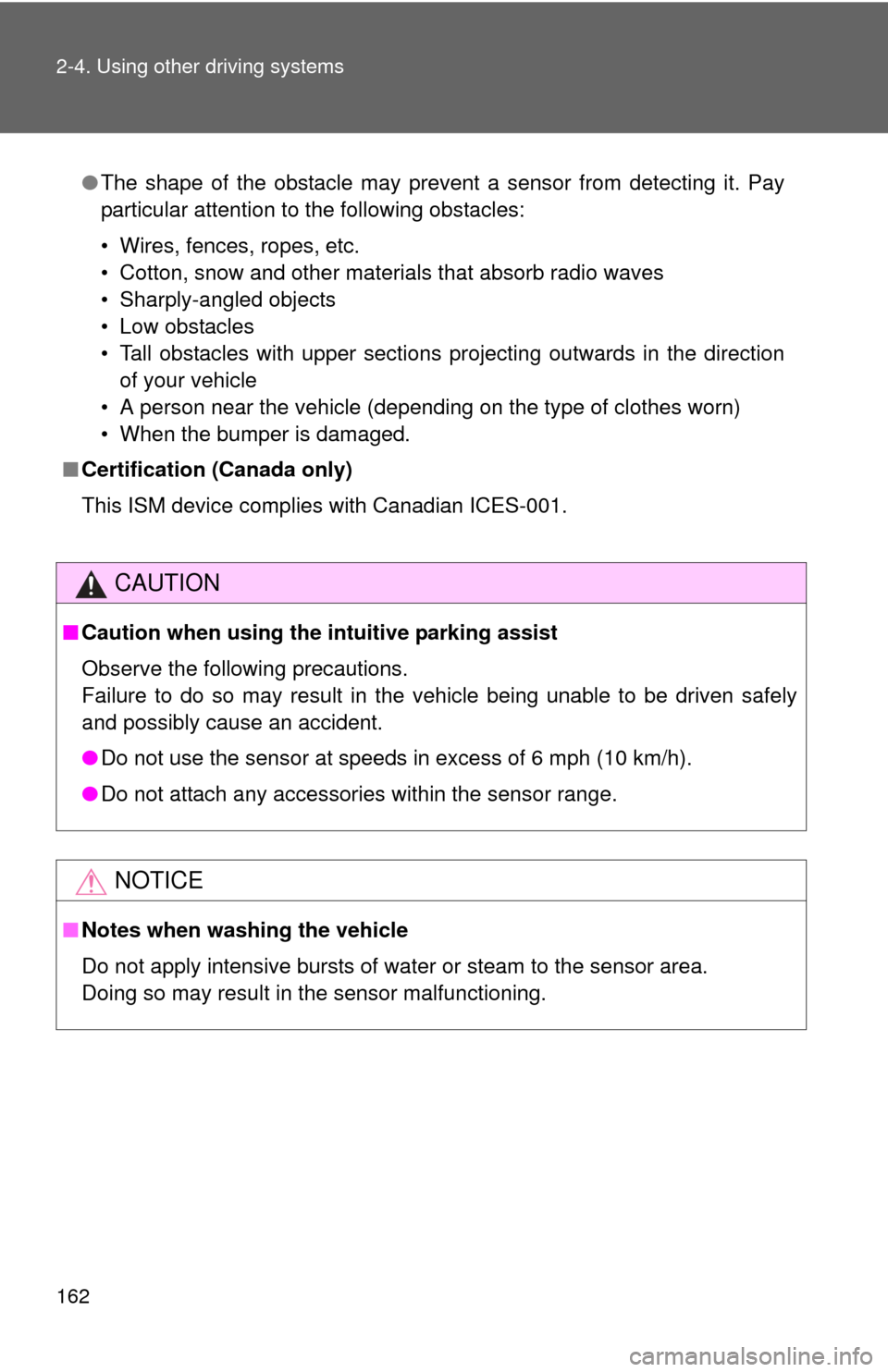
162 2-4. Using other driving systems
●The shape of the obstacle may prevent a sensor from detecting it. Pay
particular attention to the following obstacles:
• Wires, fences, ropes, etc.
• Cotton, snow and other materials that absorb radio waves
• Sharply-angled objects
• Low obstacles
• Tall obstacles with upper sections projecting outwards in the direction
of your vehicle
• A person near the vehicle (depending on the type of clothes worn)
• When the bumper is damaged.
■ Certification (Canada only)
This ISM device complies with Canadian ICES-001.
CAUTION
■Caution when using the intuitive parking assist
Observe the following precautions.
Failure to do so may result in the vehicle being unable to be driven safely
and possibly cause an accident.
●Do not use the sensor at speeds in excess of 6 mph (10 km/h).
● Do not attach any accessories within the sensor range.
NOTICE
■Notes when washing the vehicle
Do not apply intensive bursts of water or steam to the sensor area.
Doing so may result in the sensor malfunctioning.
Page 163 of 568
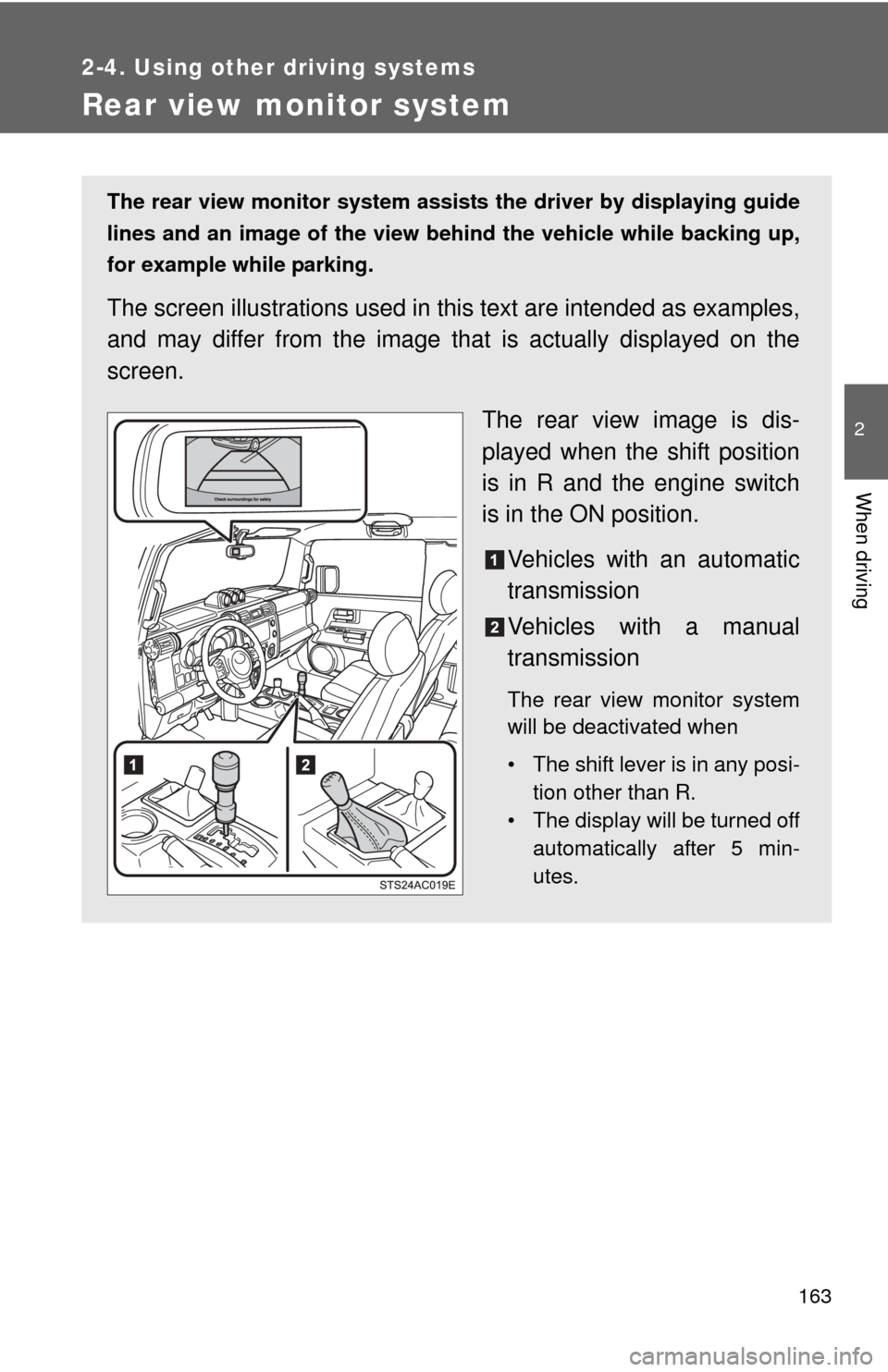
163
2-4. Using other driving systems
2
When driving
Rear view monitor system
The rear view monitor system assists the driver by displaying guide
lines and an image of the view behind the vehicle while backing up,
for example while parking.
The screen illustrations used in th is text are intended as examples,
and may differ from the image that is actually displayed on the
screen.
The rear view image is dis-
played when the shift position
is in R and the engine switch
is in the ON position.Vehicles with an automatic
transmission
Vehicles with a manual
transmission
The rear view monitor system
will be deactivated when
• The shift lever is in any posi- tion other than R.
• The display will be turned off automatically after 5 min-
utes.
Page 164 of 568
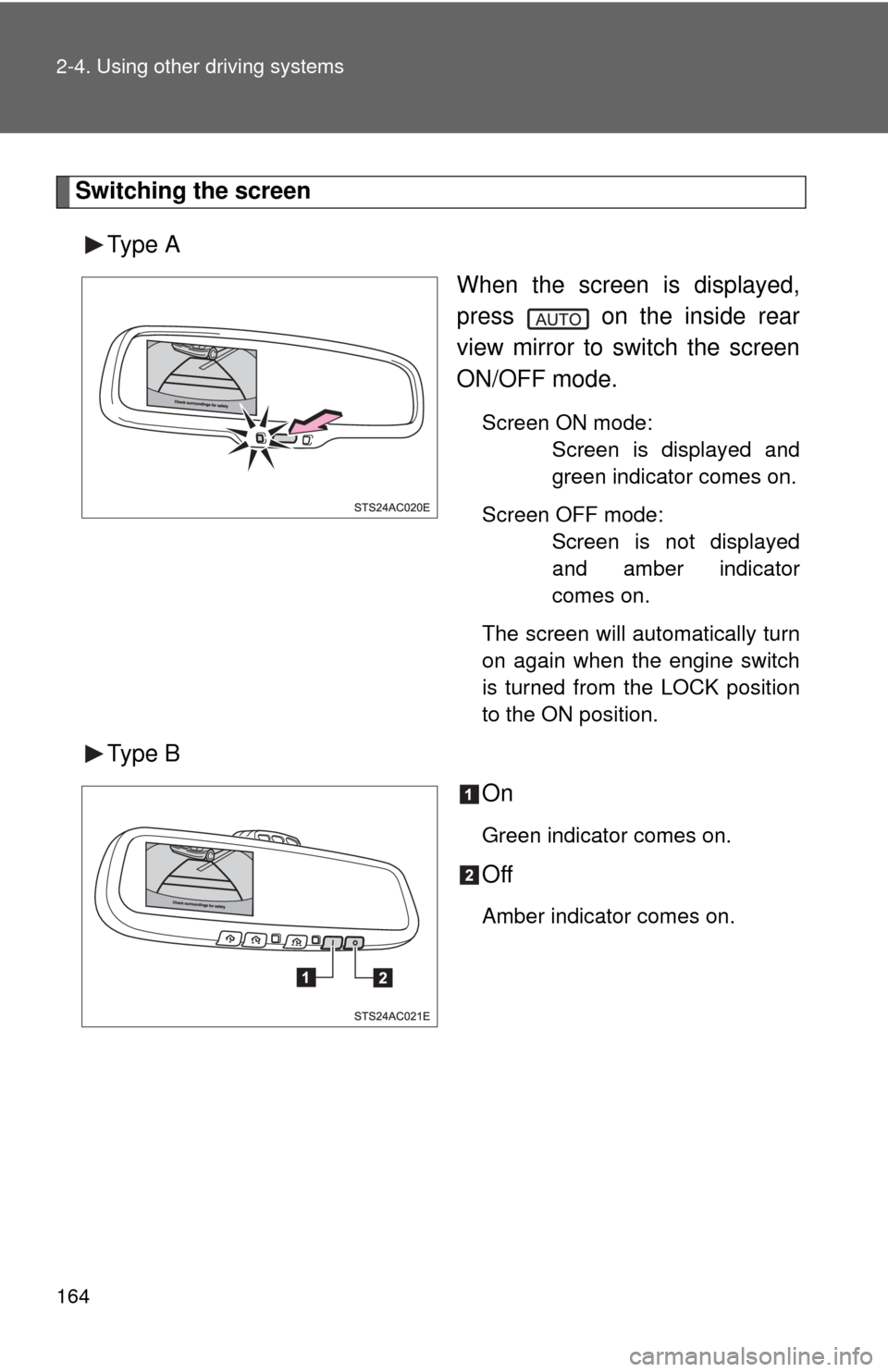
164 2-4. Using other driving systems
Switching the screenType A When the screen is displayed,
press on the inside rear
view mirror to switch the screen
ON/OFF mode.
Screen ON mode:Screen is displayed and
green indicator comes on.
Screen OFF mode: Screen is not displayed
and amber indicator
comes on.
The screen will automatically turn
on again when the engine switch
is turned from the LOCK position
to the ON position.
Type B On
Green indicator comes on.
Off
Amber indicator comes on.
Page 165 of 568
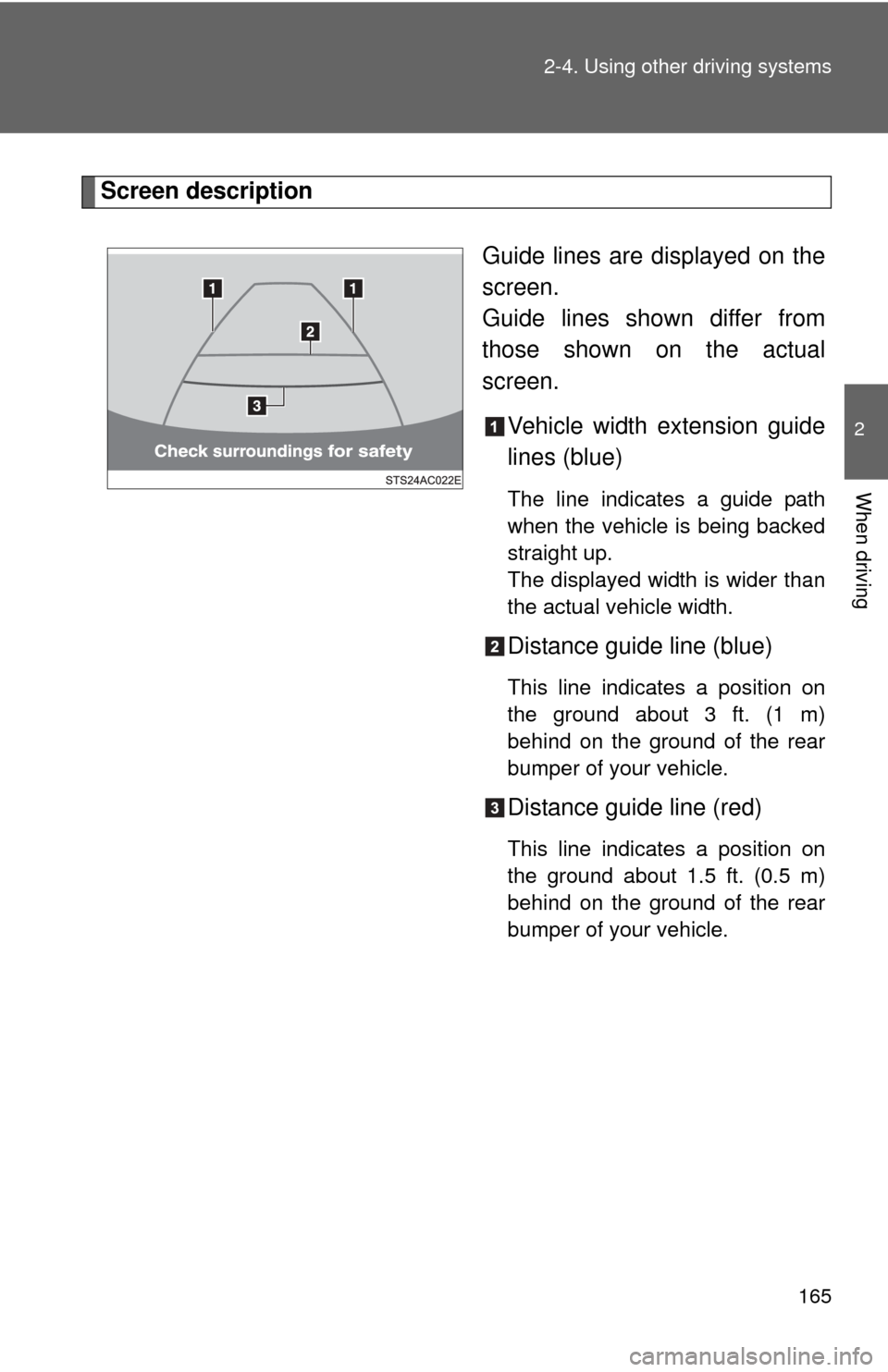
165
2-4. Using other
driving systems
2
When driving
Screen description
Guide lines are displayed on the
screen.
Guide lines shown differ from
those shown on the actual
screen.Vehicle width extension guide
lines (blue)
The line indicates a guide path
when the vehicle is being backed
straight up.
The displayed width is wider than
the actual vehicle width.
Distance guide line (blue)
This line indicates a position on
the ground about 3 ft. (1 m)
behind on the ground of the rear
bumper of your vehicle.
Distance guide line (red)
This line indicates a position on
the ground about 1.5 ft. (0.5 m)
behind on the ground of the rear
bumper of your vehicle.
Page 166 of 568
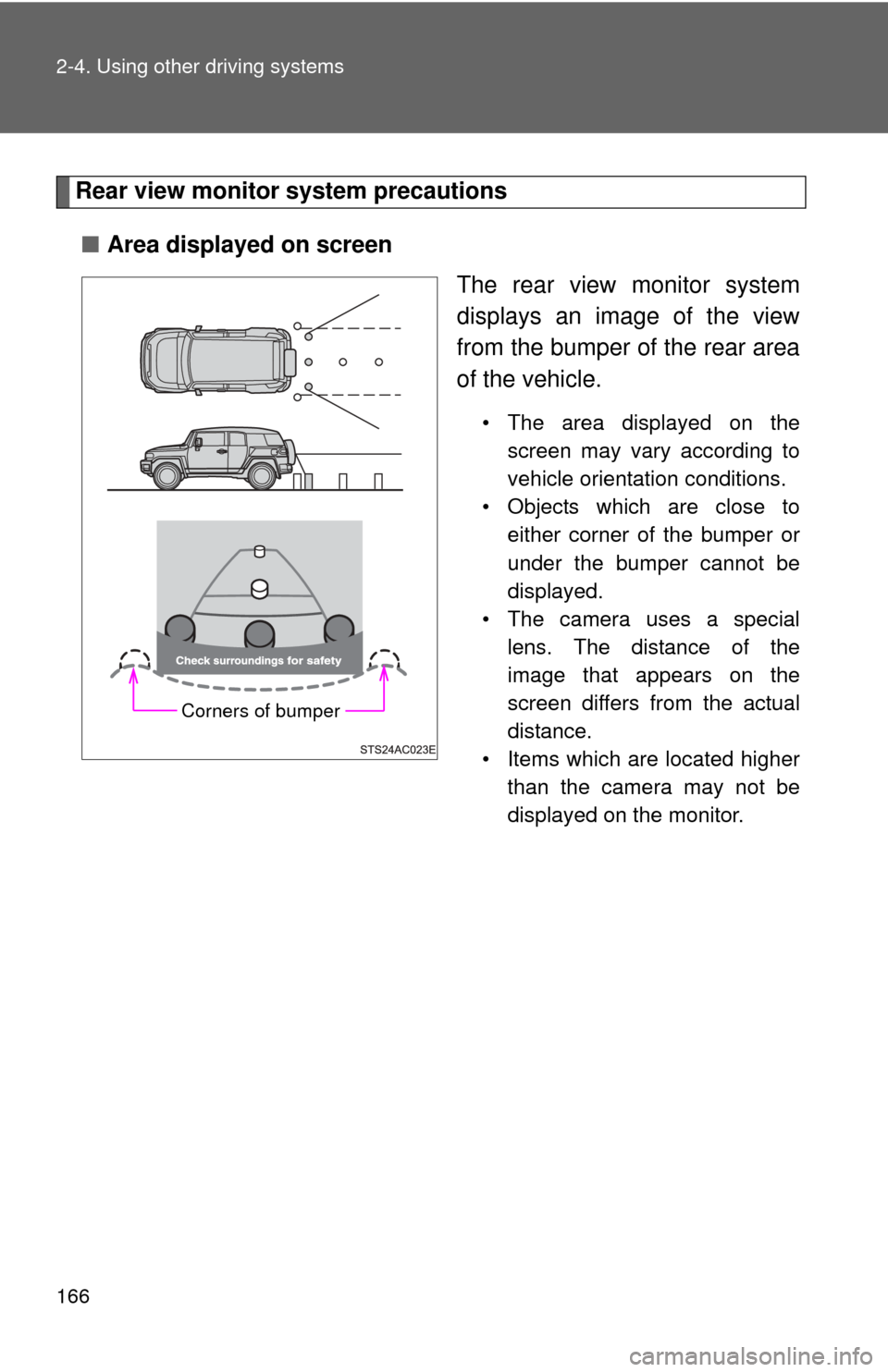
166 2-4. Using other driving systems
Rear view monitor system precautions
■ Area displayed on screen
The rear view monitor system
displays an image of the view
from the bumper of the rear area
of the vehicle.
• The area displayed on thescreen may vary according to
vehicle orientation conditions.
• Objects which are close to either corner of the bumper or
under the bumper cannot be
displayed.
• The camera uses a special
lens. The distance of the
image that appears on the
screen differs from the actual
distance.
• Items which are located higher than the camera may not be
displayed on the monitor.
Corners of bumper
Page 167 of 568
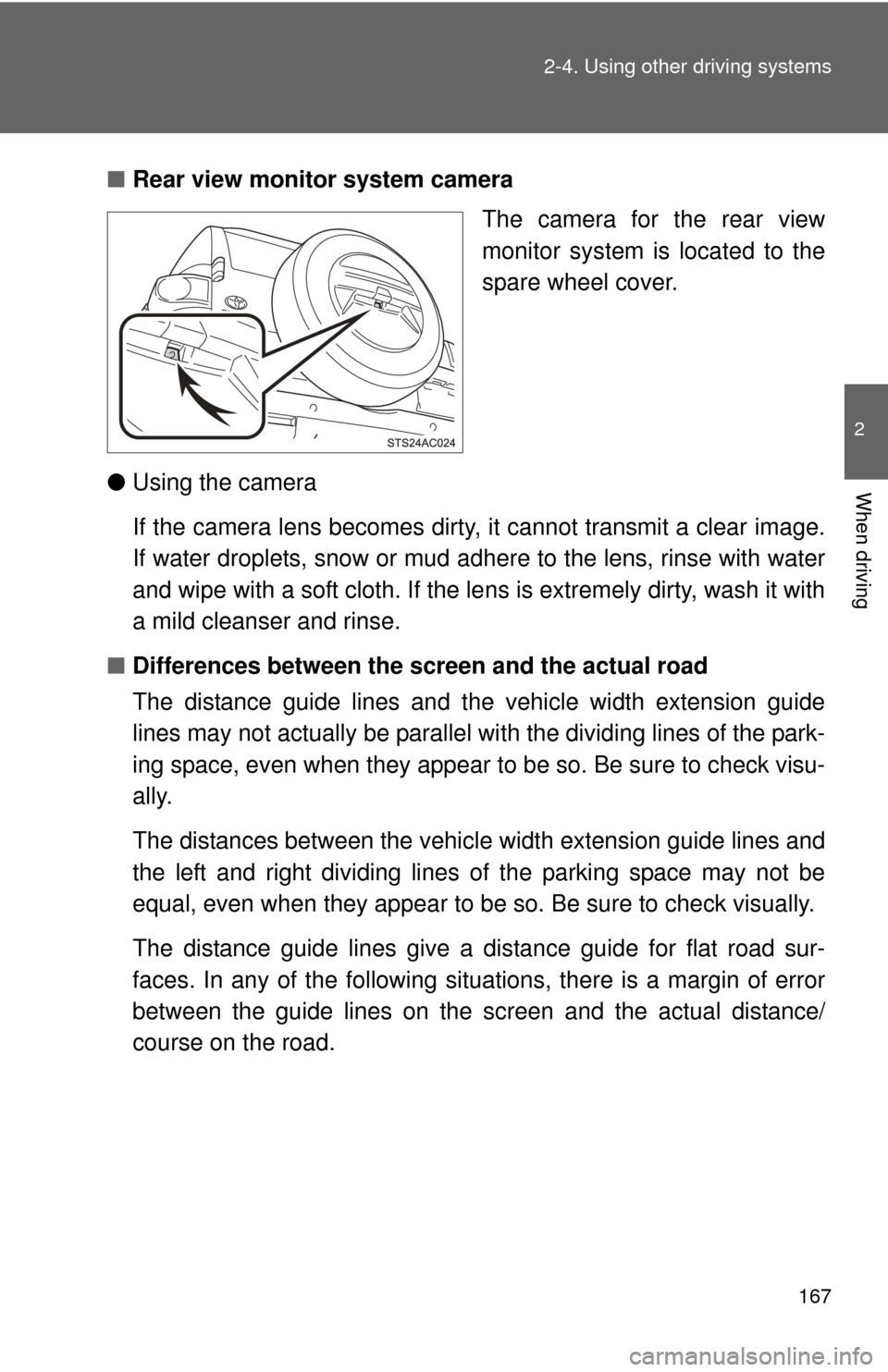
167
2-4. Using other
driving systems
2
When driving
■Rear view monitor system camera
The camera for the rear view
monitor system is located to the
spare wheel cover.
● Using the camera
If the camera lens becomes dirty, it cannot transmit a clear image.
If water droplets, snow or mud adhere to the lens, rinse with water
and wipe with a soft cloth. If the le ns is extremely dirty, wash it with
a mild cleanser and rinse.
■ Differences between the screen and the actual road
The distance guide lines and the vehicle width extension guide
lines may not actually be parallel wi th the dividing lines of the park-
ing space, even when they appear to be so. Be sure to check visu-
ally.
The distances between the vehicl e width extension guide lines and
the left and right dividing lines of the parking space may not be
equal, even when they appear to be so. Be sure to check visually.
The distance guide lines give a distance guide for flat road sur-
faces. In any of the following situations, there is a margin of error
between the guide lines on the sc reen and the actual distance/
course on the road.
Page 168 of 568
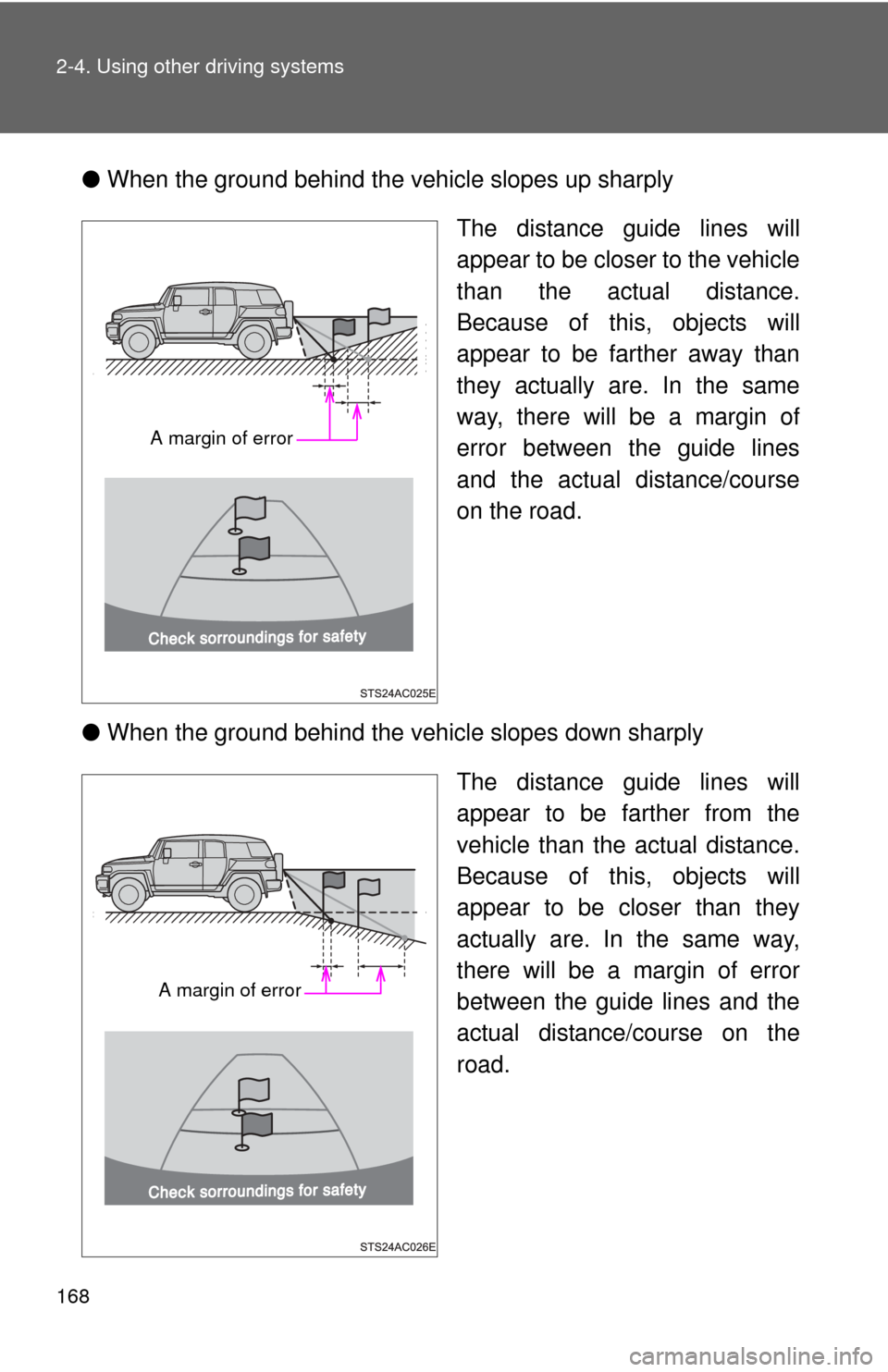
168 2-4. Using other driving systems
●When the ground behind the vehicle slopes up sharply
The distance guide lines will
appear to be closer to the vehicle
than the actual distance.
Because of this, objects will
appear to be farther away than
they actually are. In the same
way, there will be a margin of
error between the guide lines
and the actual distance/course
on the road.
● When the ground behind the vehicle slopes down sharply
The distance guide lines will
appear to be farther from the
vehicle than the actual distance.
Because of this, objects will
appear to be closer than they
actually are. In the same way,
there will be a margin of error
between the guide lines and the
actual distance/course on the
road.
A margin of error
A margin of error
Page 169 of 568
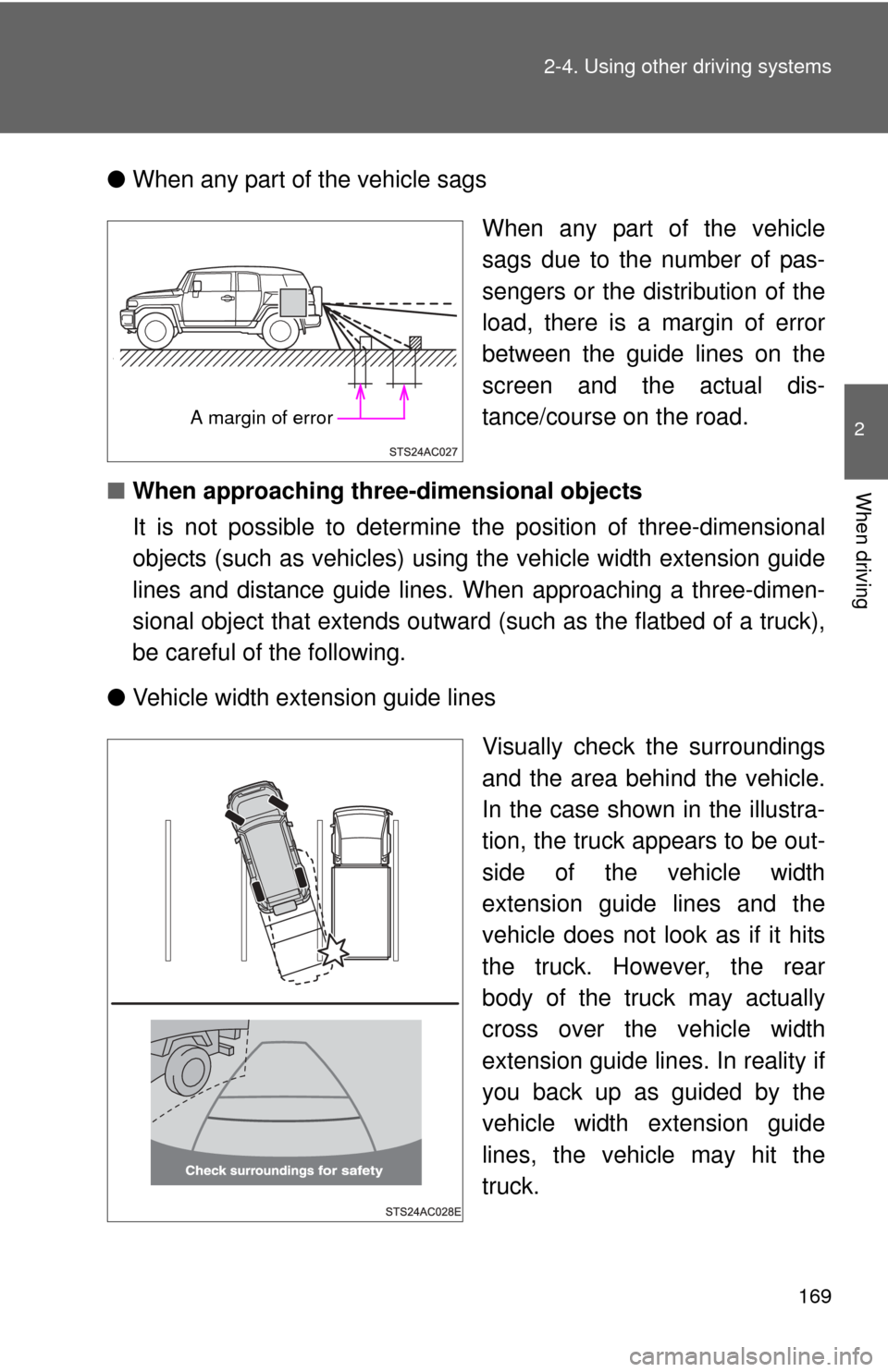
169
2-4. Using other
driving systems
2
When driving
●When any part of the vehicle sags
When any part of the vehicle
sags due to the number of pas-
sengers or the distribution of the
load, there is a margin of error
between the guide lines on the
screen and the actual dis-
tance/course on the road.
■ When approaching three-dimensional objects
It is not possible to determine t he position of three-dimensional
objects (such as vehicles) using the vehicle width extension guide
lines and distance guide lines. When approaching a three-dimen-
sional object that extends outward (such as the flatbed of a truck),
be careful of the following.
● Vehicle width extension guide lines
Visually check the surroundings
and the area behind the vehicle.
In the case shown in the illustra-
tion, the truck appears to be out-
side of the vehicle width
extension guide lines and the
vehicle does not look as if it hits
the truck. However, the rear
body of the truck may actually
cross over the vehicle width
extension guide lines. In reality if
you back up as guided by the
vehicle width extension guide
lines, the vehicle may hit the
truck.
A margin of error
Page 170 of 568
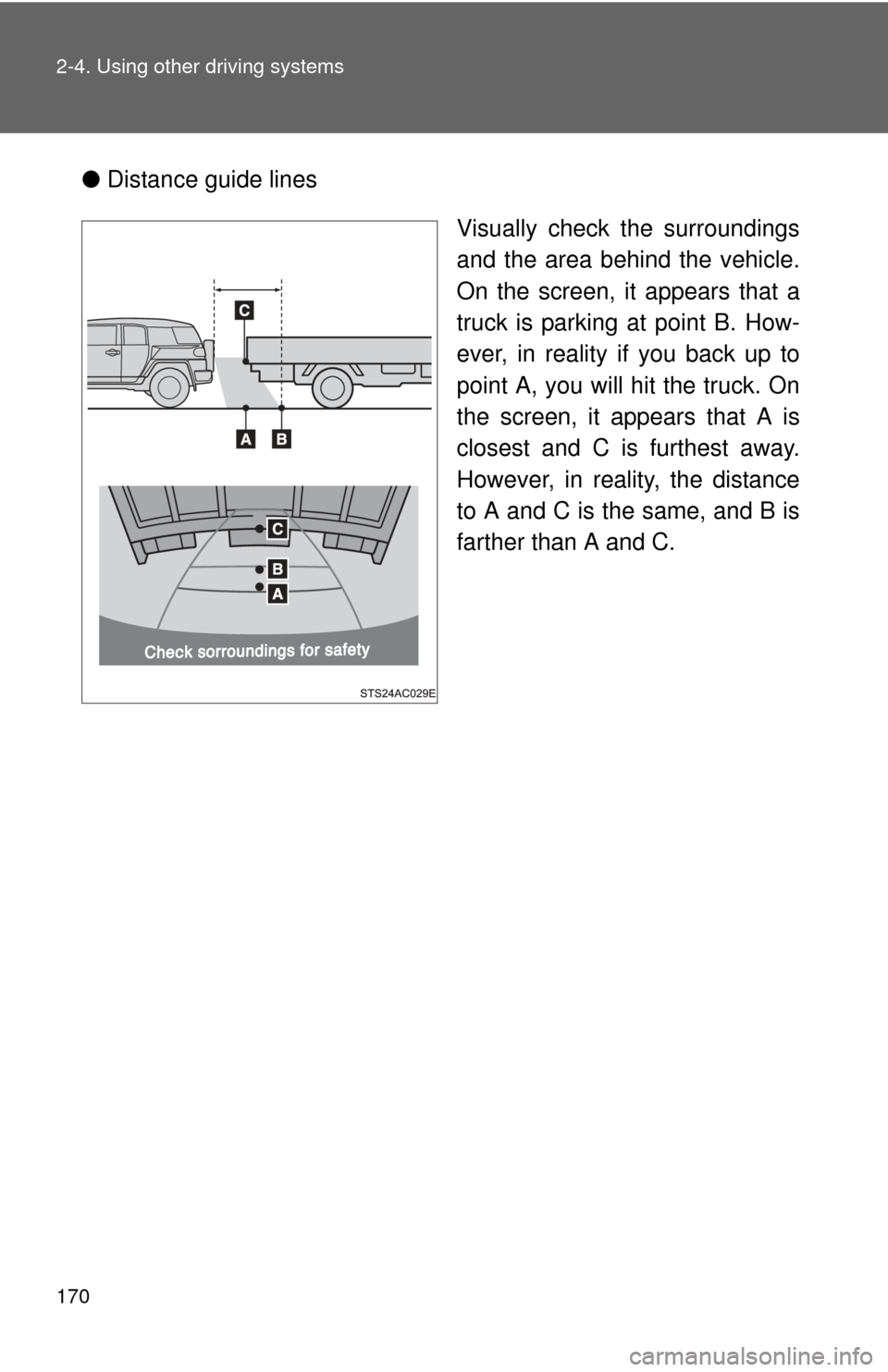
170 2-4. Using other driving systems
●Distance guide lines
Visually check the surroundings
and the area behind the vehicle.
On the screen, it appears that a
truck is parking at point B. How-
ever, in reality if you back up to
point A, you will hit the truck. On
the screen, it appears that A is
closest and C is furthest away.
However, in reality, the distance
to A and C is the same, and B is
farther than A and C.